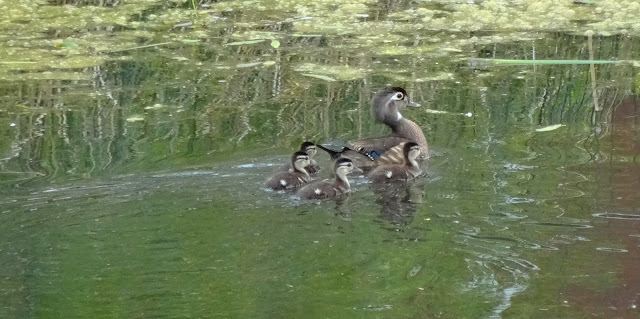11/07/2023
new feathers
In November, Mallards paddle on the pond before they migrate to warmer places. The male Mallards molt their feathers in the autumn and regrow their green head feathers; in the following spring brilliant colors will help each male find a mate for the next breeding season.
9/01/2023
duck house
We put up a nesting box for ducks last Spring, especially Hooded Mergansers.
It was too late for nesting season, but I read that sometimes they scout out in the autumn a place to nest next Spring.
We hope this female is scouting!
6/17/2023
5/21/2023
5/09/2023
pair of blue winged teal
4/25/2023
northern shovelers in Spring
Northern Shovelers visited the pond today. They eat tiny crustaceans, other aquatic invertebrates, and seeds in and around the pond. To filter food out of the water, they have comb-like projections (called lamellae) along the edge of their bills. Lamellae are slightly pliable. They help many ducks, gooses, and other birds eat by filtering edible items from mud or water.
4/20/2023
hooded mergansers in Spring
We have three types of Mergansers in North America. The smallest of the group is the Hooded Merganser. These are diving ducks; their long bills are slender with serrated edges, formed like teeth for grasping and holding their prey. They dive in lakes or ponds, staying under water up to two minutes, while hunting for small fish, crustaceans, amphibians, or roots.
4/16/2023
blue-wing teal in Spring
4/05/2023
mallards arriving
Even though Spring is here and the birds have been moving to their nesting areas in Minnesota, the ice is thick on the middle of ponds. The Mallard pair is finding food in the open water near the shore. They act like ice-breakers with their beaks and legs to get to the plant material beneath the water.
7/16/2022
turtle chases ducks off favorite rock
7/05/2022
7/03/2022
mallard families
Female Mallard came out of the grasses with her 3 young ducks (upper right). Then, another Mallard appeared with her 8 younger ducklings. They were all intent on eating duckweed and other aquatic plants growing in the pond.
5/02/2022
blue-winged teal
4/15/2022
dabblers and divers
The pond area is bustling with birds arriving! Several species of ducks have stopped for a meal or a day of rest on migration. I marvel at how they tolerate one another in this small spot of respite. Occasionally we hear honking or see disputes, but mostly the creatures get along.
Animals have adapted their method to feed in different ways. For instance, we saw Mallards feeding near Hooded Mergansers. Mallards and Blue-winged Teal are ‘dabblers' – they dip their beak and head into the water to munch on shallow-water plants. Mergansers are ‘divers' – they dive totally under the water to eat plants growing in deep water.
4/14/2022
ducks on log
Hooded Mergansers Lophodytes cucullatus appear prominently on the pond when the weather is nice (you can not miss their dazzling appearance and active diving), and they disappear from view when it is not nice. This year, April has been colder than normal, rainy, and with mostly gray skies.
Waterfowl like these are here on their nesting ground. They can find shelter from bad weather in the weeds and reeds around the pond. This Hooded Merganser pair can find plenty to eat here . . . small frogs, tadpoles, insects, seeds, and even the roots or bulbs of water plants. When they're satisfied, the pond offers several exposed rocks, logs, and shallow bars for critters to use as loafing sites.
Next up -- finding a nesting site.
3/21/2022
'homing' Mallards
Mallards can stay through winter in Minnesota if they can find food near open water. Now that the solid shore-to-shore ice on the pond is melting, a pair showed up here. This is probably the same pair that nested near the pond last year, since Mallards are known to 'home' where they have nested previously.
Even though a fractured layer of ice floats nearby, these ducks find food beneath the water. This might be what is known as a 'cold lunch'.
10/25/2021
muskrats chasing ducks
8/30/2021
mallard twins and lone goose
7/28/2021
convivial ducks
This summer has been very scant on rainfall so far. The pond water level is currently low, and there is plenty of algae floating. But the rocks are always good places for sharing the sunshine. Female Mallard and Hooded Merganser have raised their young broods here, and shared the big rock today.
6/27/2021
new Mallards, second clutch
Mallard female has been hiding her second clutch of eggs near the pond among grasses. Today she led all 6 hatched ducklings to the pond, where they paddled around and started to feed. They can eat seeds, stems, and roots of many different plants; also aquatic invertebrates such as worms, beetles, dragonflies, or insect larvae.























